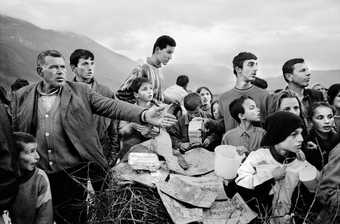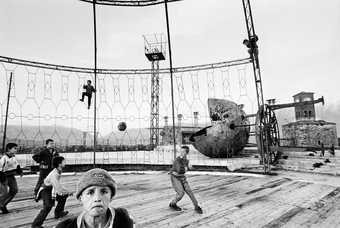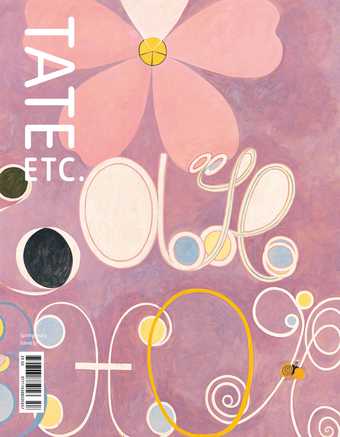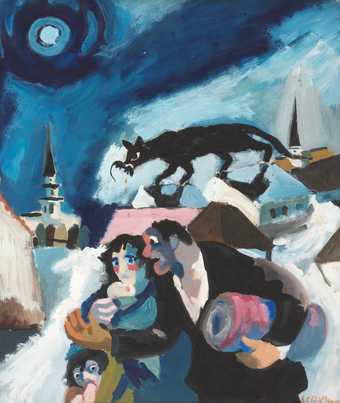
Vanessa Winship
Kukës, Albania (1999–2002)
Tate
In one image by the British photographer Vanessa Winship, a group of Kosovan refugees – mostly children – stand on a hillside, staring fixedly in the same direction. Whatever they are looking at is out of shot. An older man holds out his arm in a gesture that is part reprimand, part plea. The children around him look fearful; some clutch empty buckets and pots. While the picture looks gloomy with the thick clouds rolling above them, what is most moving about this image is the sturdy, determined and dignified expressions worn by some of the figures, despite the devastation in front of them. The picture was taken at a transit camp in May 1999 – towards the end of the Kosovo War – in the mountainous Kukës region in Albania. This photograph is one of several works in Tate’s collection from Winship’s first major photographic series Imagined States and Desires: A Balkan Journey 1999–2002, which documented the ruin of war in this region.

Vanessa Winship
Shkoder, Albania (1999–2002)
Tate
Winship’s work is not only a photographic documentation of the Balkan conflict but a beautiful, powerful record of the lived experience of war. Her images show us families creating homes in makeshift tents in refugee camps or children playing in decimated buildings. Without hiding the uncertainty, humiliation and confusion of war, her series allows us to sit with the plight of the displaced.
In another image, shot in a refugee camp in Shkodër, Albania, three young men are pictured in a cell-like room, bare of furniture save for a slatted bench on the concrete floor. One young man is giving a haircut to another, while a third stares intently into a small hand mirror. It is an almost ordinary scene, familiar yet distant. In Winship’s photographs we, the viewers, see refugees in their humanity – not as faceless hordes, or silent actors, but as fully formed people going through a harrowing experience.

Vanessa Winship
Gjirokaster, Albania (1999–2002)
Tate
In the years after the so-called ‘migrant crisis’ of 2015, one of the most photographed humanitarian crises in history, there was an explosion in the visual representations of refugees in the media. The most popular and prevalent images were dehumanising, reducing the complex experiences of displaced people to simple binaries: vulnerable bodies or dangerous outsiders. Refugees also appeared in visual art from films by Ai Weiwei, or Italian director Gianfranco Rosi’s Golden-Bear winning documentary Fire at Sea, set on Lampedusa Island, and Christoph Büchel’s Barca Nostra (‘Our Boat’, 2018–19), a migrant shipwreck installation at the 2019 Venice Biennale.
In recent months, we have quite rightly seen thousands of images and videos of the conflict in Ukraine, but we have to question whether we are getting the whole picture. When we miss the nuances of the refugee experience, we tend to repeat a single refugee story and overlook the rest. The deadliest conflict in the world today is not in Ukraine but in Ethiopia’s Tigray region, where an estimated 600,000 people have been killed since the war began in November 2020, more than 3.5 million people have been internally displaced and 6 million people are facing a health emergency. But this crisis has been largely forgotten, raising urgent questions not only about how refugees are visually depicted but why some conflicts seem to matter more than others. Until we follow Winship’s example and see that all refugees matter, then the stories of the people of Tigray will remain peripheral, and out of sight.
Ismail Einashe is a journalist and writer, and member of the Tate Etc. editorial board.
Kukës, Albania, Shkoder, Albania and Gjirokaster, Albania were purchased with funds provided by the Photography Acquisitions Committee in 2019.




